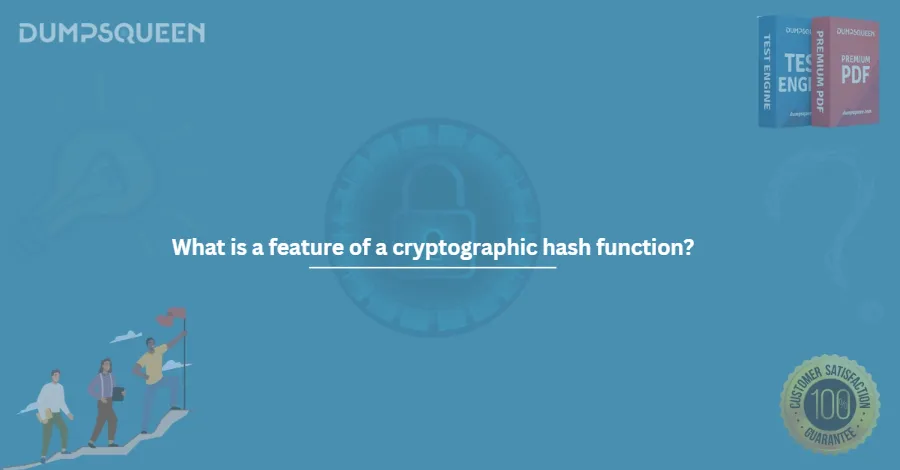Understanding Cryptographic Hash Functions: A Guide to SY0-701 Exam Preparation
Cryptography has always been a cornerstone of information security, ensuring that data remains secure, confidential, and unchanged during transmission or storage. Among the various cryptographic techniques, hash functions stand out as one of the most important mechanisms for securing data. They form the backbone of data integrity in various security protocols, such as digital signatures, password storage, and data verification.
In this article, we will explore the concept of cryptographic hash functions, delve into their core features, and demonstrate their relevance to the SY0-701 exam, a key certification for individuals interested in pursuing a career in cybersecurity. Additionally, we will highlight how DumpsQueen's resources can aid candidates in mastering these critical topics for the exam.
Brief Definition of a Cryptographic Hash Function
A cryptographic hash function is a mathematical algorithm that transforms any input data (also known as a "message") into a fixed-length string of characters, which is typically a sequence of numbers and letters. This output, known as the "hash value" or simply "hash," is unique to the given input. Even the smallest change to the input data will result in a completely different hash value.
One of the key properties of a cryptographic hash function is its one-way nature. This means that, given the hash value, it is computationally infeasible to reverse the process and retrieve the original input. This makes hash functions ideal for applications such as verifying the integrity of data, creating digital signatures, and storing passwords securely.
Cryptographic hash functions are designed to be fast to compute but extremely difficult to reverse. They are also deterministic, meaning that the same input will always produce the same hash value, which is critical for verifying data integrity and authenticity.
Core Features of a Cryptographic Hash Function
To better understand the role of cryptographic hash functions, it is important to explore their core features. These features ensure that the hash functions provide the security and reliability needed in cryptography.
1. Deterministic
As mentioned, a cryptographic hash function is deterministic, meaning that it will always produce the same output for the same input. For instance, if you hash the word “apple” using a specific algorithm, the result will always be the same hash value every time.
2. Fixed-Length Output
Regardless of the size of the input data, a cryptographic hash function generates a fixed-length output. For example, the popular SHA-256 hash function generates a 256-bit hash value, irrespective of whether the input is a single character or a large file. This fixed-length output is crucial for maintaining the integrity of the data, especially when verifying or comparing large sets of data.
3. Pre-image Resistance
Pre-image resistance is a property that ensures it is computationally difficult to find an input that hashes to a specific output. In simpler terms, given a hash value, it should be nearly impossible to figure out the original input. This is a critical feature in cryptographic applications, where it is vital to keep the original data hidden from unauthorized parties.
4. Collision Resistance
Collision resistance refers to the difficulty of finding two different inputs that produce the same hash value. A good cryptographic hash function should make it computationally infeasible to find two distinct inputs that hash to the same output. This property is essential in preventing attacks where an adversary could swap data (e.g., a file or message) with another file that has the same hash.
5. Avalanche Effect
The avalanche effect is a phenomenon where a small change in the input (even changing just one bit) results in a drastically different hash value. This ensures that similar inputs will not produce similar hash values, making it harder for attackers to predict or manipulate the output based on the input.
6. Efficiency
A cryptographic hash function should be efficient to compute, allowing systems to process large amounts of data quickly. This is essential for systems that need to handle large volumes of data while maintaining speed and security.
Relevance to SY0-701 Exam
The CompTIA Security+ SY0-701 exam is one of the most recognized certifications in the field of cybersecurity. It is designed to assess the knowledge and skills necessary for individuals to protect information systems and networks. Cryptographic hash functions are a key topic in this exam, especially within the domain of encryption and cryptography.
Here are a few ways that cryptographic hash functions relate to the SY0-701 exam:
1. Cryptography Concepts
Understanding cryptographic hash functions is essential for grasping the broader concept of encryption in cybersecurity. The SY0-701 exam covers various cryptographic methods, and hash functions play a critical role in securing data and ensuring its integrity. Candidates should be familiar with how hash functions are used in technologies like SSL/TLS, digital signatures, and certificate authorities.
2. Digital Signatures and Certificates
Digital signatures rely on cryptographic hash functions to provide authenticity and integrity for electronic documents. The hash of a document is signed with a private key, and the recipient can use the public key to verify the integrity of the document. This process is essential for ensuring non-repudiation and verifying the source of the information. Understanding how hash functions are used in digital signatures is crucial for the SY0-701 exam.
3. Data Integrity and Non-repudiation
Cryptographic hash functions are widely used to verify data integrity. When data is transmitted over a network, the sender can send the hash of the data along with it. The recipient can then compute the hash of the received data and compare it to the sent hash to ensure no tampering occurred during transmission. This is an important topic for candidates preparing for the SY0-701 exam, as it ties into the concepts of data integrity and non-repudiation.
4. Password Storage
Cryptographic hash functions are used extensively in password storage systems. When users create accounts on websites, their passwords are often hashed and stored in databases rather than stored in plain text. This ensures that even if the database is compromised, the actual passwords remain secure. The SY0-701 exam covers password security best practices, and understanding the role of hash functions in this context is vital.
5. Hashing Algorithms
The SY0-701 exam includes questions on specific hashing algorithms, such as SHA-256 and MD5. Candidates must be able to identify the strengths and weaknesses of various algorithms and understand when each should be used. While MD5 and SHA-1 were once popular, they are now considered weak due to vulnerabilities that make them susceptible to collision attacks. Candidates need to be aware of these risks and the recommended use of more secure algorithms like SHA-256.
How DumpsQueen Can Help You Prepare for the SY0-701 Exam
As you prepare for the SY0-701 exam, DumpsQueen offers an invaluable resource for mastering cryptographic concepts, including hash functions. DumpsQueen provides comprehensive study materials, including practice exams, detailed study guides, and video tutorials, specifically tailored to the topics covered in the SY0-701 exam.
Here are some of the ways DumpsQueen can assist you in preparing for the cryptographic aspects of the SY0-701 exam:
1. Comprehensive Study Guides
DumpsQueen offers in-depth study guides that cover the core features and applications of cryptographic hash functions. These guides break down complex topics into easy-to-understand explanations, helping you grasp the essential concepts needed to succeed on the exam.
2. Practice Exams
DumpsQueen’s practice exams are designed to simulate the real SY0-701 test environment. With questions related to cryptographic hash functions and other encryption topics, you can test your knowledge and improve your performance before the actual exam. These practice exams provide feedback on your strengths and areas that need improvement, ensuring that you are fully prepared.
3. Up-to-Date Content
The field of cybersecurity is ever-evolving, and DumpsQueen ensures that its study materials are regularly updated to reflect the latest industry standards and exam objectives. Whether it’s new cryptographic algorithms or changes in hashing best practices, you can rely on DumpsQueen to provide the most current and relevant information for your exam preparation.
4. Expert Support
DumpsQueen offers access to expert instructors and support staff who can answer your questions and provide additional clarification on difficult topics. If you’re struggling to understand a particular concept related to cryptographic hash functions or any other aspect of the SY0-701 exam, DumpsQueen is here to help.
Conclusion
Cryptographic hash functions are a critical component of modern cybersecurity, playing a vital role in data integrity, password storage, and digital signatures. Understanding how they work and their core features is essential for anyone preparing for the SY0-701 exam.
With DumpsQueen's resources, candidates can confidently study and prepare for the exam, gaining a deep understanding of cryptographic techniques and ensuring their success in the cybersecurity field. Whether you’re looking for study guides, practice exams, or expert support, DumpsQueen provides everything you need to pass the SY0-701 exam and take the next step in your cybersecurity career.
Free Sample Questions
What is a key feature of a cryptographic hash function?
A) It generates a variable-length output regardless of input size.
B) It produces a fixed-length output for any input.
C) It allows easy reversal to obtain the original input.
D) It requires a secret key to compute the hash.
Answer: B) It produces a fixed-length output for any input.
Which property ensures a cryptographic hash function is secure?
A) Collision resistance, making it hard to find two inputs with the same hash.
B) Allowing multiple inputs to produce the same hash easily.
C) Storing the original input within the hash output.
D) Using reversible algorithms to compute the hash.
Answer: A) Collision resistance, making it hard to find two inputs with the same hash.
What does the pre-image resistance feature of a cryptographic hash function mean?
A) It is computationally infeasible to find any input that produces a given hash.
B) The hash can be reversed to reveal the input with minimal effort.
C) The hash output changes drastically with a large input change.
D) It requires a public key to verify the hash.
Answer: A) It is computationally infeasible to find any input that produces a given hash.
Which feature of a cryptographic hash function ensures small input changes produce significant output changes?
A) Determinism
B) Avalanche effect
C) Key dependency
D) Reversibility
Answer: B) Avalanche effect
What is a characteristic of a cryptographic hash function’s determinism?
A) The same input always produces the same hash output.
B) The output varies each time the same input is hashed.
C) It requires external randomness to generate the hash.
D) It produces a hash based on the time of computation.
Answer: A) The same input always produces the same hash output.




